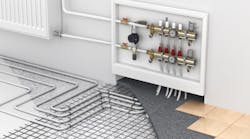Latest from Eatherton
Sponsored
On my last article (April 2018) I explained that we’d go into depth to discuss the proper commissioning of some of our newer hydronic heating systems. Suffice to say, there are no less than a 1000 different ways to do a system, but they all contain the same basic equipment. From the heat source side, the “boiler” could be something as simple as an atmospheric fired boiler, or as complicated as a Ground Source Heat Pump system. Regardless of what it is and where it is located, it must be commissioned, and in some cases, minor adjustments made to fine tune its operation, and then its condition at the time of start-up and commission noted, and copies of this report distributed to the appropriate parties. Let’s start with the heat sources.
The boiler: Inasmuch as my expertise is in gas fired equipment, that will be the focus of my articles. Regardless of whether the device is powered with natural gas or Liquified Propane, the incoming static fuel pressure must be measured, possibly adjusted and recorded. All appliance manufacturers provide the minimum and maximum allowable operating pressure for static conditions. It is critical that these recommendations be followed and complied to. With today’s various fuel delivery systems, I find that it is also important to document not only the incoming “static” pressures of the fuels, but also important to document the “dynamic” or real time operating pressures of the fuel systems.
A person has to test under the highest draw demands in order to assure that their appliance will operate at its full potential when design conditions come around. Granted, here in middle America, design conditions occur for less that 2% of the time, but that is not when you want to find out that there are issues with the fuel distribution system, regardless of who installed it. This will require you to simulate loads in order to exert some stress on the fuel delivery system. You will need to fire up any stand-alone gas fired heaters connected to this fuel delivery system, as well as firing up ranges, fireplaces and clothes dryers within the dwelling. Note the static pressure with nothing running, and with everything running. The gas pressure at the appliance may need to be documented before the appliance gas valve, and in some cases after the appliance gas valve. Make certain that it meets the manufacturers minimum required pressure in order to ensure proper operation at design condition.
I prefer the use of non-digital tools. They are more robust, do not require extreme temperature control, and are simple to read and can be easily to calibrate yourself, avoiding the need to ship them to remote locations for calibration.
There are numerous tools available on the open market for reading these pressures. This tool is called a manometer (man-AW-meter). In most cases, the pressures you will be reading are down stream of higher pressure regulators, and a device that can read in inches of water column are the norm. You may on occasion be required to read the pressure upstream of the appliance regulators, which may require an instrument capable of reading in pounds per square inch. In some cases, with newer equipment, you will need a pressure differential manometer in order to set up and adjust some of the negative pressure regulation control valves associated with modulating equipment. And some meters have numerous ranges and capabilities.
All electronic metering devices like this should be sent back to the factory once every year or two, depending upon the manufacturer, for factory re-calibration. Take this into consideration when purchasing, so you don’t short yourself instruments in the field, while yours is on vacation being re-calibrated. Always read the manufacturers use and care instructions. Some meters do not like being kept in a cold storage situation, like a service van. The reasoning behind this is that when it is taken out of the cold environment, and placed inside a warm, humid building environment, dew will form on some critical sensing elements, and it will affect the instruments accuracy. At present, there are no low cost heated tool storage boxes available, so the best policy is to keep all temperature sensitive tools in a “Safe Box” that can be easily removed from the service van and stored in a heated environment. Just remember to pull the box inside your building when cold weather is expected, and then remember to put it back in the van before you leave your office for the job site.
Personally, I prefer the use of non-digital tools. They are more robust, do not require extreme temperature control, and are simple to read and can be easily to calibrate yourself, avoiding the need to ship them to remote locations for calibration. The only problem is one of reading range-ability. The gauge you use for reading inches of water column, will most probably not be the same gauge that is used for measuring pounds per square inch. Tools like this are a personal decision. Just bear in mind the application, purchase costs and the costs of ownership before you pull the trigger for purchase.
Keeping these tools isolated in their own foam lined case will ensure years of life expectancy, without any major problems. In fact, I keep all of my instruments in one handy, sponge foam lined, wheeled tool box that I keep at ready access within the service vehicle. I know that I will generally need all of the instruments that I’ll be covering in this series of articles when it comes time to perform the commissioning events for a given appliance, so it doesn’t make sense to store them in their own separate storage boxes. It also provides a great place to keep the Operations Manuals in one convenient, easy to get to location.
Tune in next month as we continue this journey into commissioning. Until then, Happy Hydronicing!
Mark Eatherton material, in print and online, is protected by Copyright 2017. Any reuse of this material (print or electronic) must first have the express written permission of Mark Eatherton and CONTRACTOR magazine. Please contact via email at [email protected].
Mark Eatherton
Mark Eatherton material on this website is protected by Copyright 2017. Any reuse of this material (print or electronic) must first have the expressed written permission of Mark Eatherton and CONTRACTOR Magazine.


